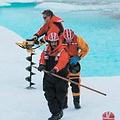 美國紐澤西大學與聯邦政府11日發表北極海底的最新觀測資料,顯示阿拉斯加大陸坡腳位置應外推100海里,與海岸的距離比過去的估計更遠。 美國可依此觀測資料延伸海床自然資源主權範圍,超越一般認定的「從領海基線起算200海里」範圍。(更正註)
美國紐澤西大學與聯邦政府11日發表北極海底的最新觀測資料,顯示阿拉斯加大陸坡腳位置應外推100海里,與海岸的距離比過去的估計更遠。 美國可依此觀測資料延伸海床自然資源主權範圍,超越一般認定的「從領海基線起算200海里」範圍。(更正註)
紐澤西大學海道量測聯合中心主任梅爾博士(Larry Mayer)負責主持本次觀測計畫,他表示,「我們證明大陸坡腳比先前所認定的更遠,是非常重大的發現。」
梅爾也說,「探究北極的海底地形與地質歷史,是了解全球氣候變化的重要環節。北極等於是地球的樞紐,控制了深海洋流的動向,因此能影響地球熱能的傳送與氣候。北極就像是全球氣候的預警系統。」
 研究人員利用精密的聲納系統在阿拉斯加進行調查,之前對這塊海域的了解有限,這次觀測提供許多詳細的資料及影像,涵蓋了5000海里的航程距離。
研究人員利用精密的聲納系統在阿拉斯加進行調查,之前對這塊海域的了解有限,這次觀測提供許多詳細的資料及影像,涵蓋了5000海里的航程距離。
海洋與大氣總署(NOAA )主任阿姆斯壯(Andy Armstrong)表示,「對NOAA與美國來說,這些都是相當珍貴的資料。更令人開心的是,我們把這些資料開放讓所有的人使用。」資料可由海道量測聯合中心網頁取得。
所有的沿海國家都擁有大陸棚(continental shelf)內的自然資源主權,通常以距離海岸200海里的範圍認定。
美國參議院正在審議海洋法公約(The Law of the Sea Convention),根據這項國際公約,若有適當的科學資料佐證,國家可在特殊的地質條件下,將海床自然資源主權延伸至大陸坡腳之外,並取得國際間的認可。
The foot of the continental slope off Alaska is more than 100 nautical miles farther from the U.S. coast than previously assumed, according to new Arctic sea floor data released today by the University of New Hampshire and the federal government.
The data could support U.S. rights to natural resources of the sea floor beyond the generally accepted limit of 200 nautical miles from the coast.
"We found evidence that the foot of the slope was much farther out than we thought. That was the big discovery," said Dr. Larry Mayer, expedition chief scientist and co-director of the Joint Hydrographic Center at University of New Hampshire.
"Understanding the bathymetry and geological history of the Arctic is an important part of understanding global climate change," said Mayer. "The Arctic acts as a global spigot in controlling the flow of deep ocean currents that distribute the Earth’s heat and control climate. The Arctic is the canary in the coal mine."
Scientists used sophisticated echo sounders to survey this little-known region, providing more detailed data and images than existed previously as they mapped about 5,000 linear nautical miles.
"These are valuable data for NOAA and the United States, and I’m pleased that we’re making them available for anyone to use," said the NOAA co-director, Andy Armstrong. The data are available at the Joint Hydrographic Center website.
Any coastal nation has sovereign rights over the natural resources of its continental shelf, generally recognized to extend 200 nautical miles out from the coast.
The Law of the Sea Convention, an international treaty now under consideration in the U.S. Senate, provides nations an internationally recognized basis to extend their sea floor resource rights beyond the foot of the continental slope if they meet certain geological criteria backed up by scientific data.
全文及圖片詳見 :ENS





